
In the summer of 1951 my family moved from Kelso to Langbank. Langbank was a much bigger more modern place than Kelso it had 84 people and Jack Hurst ran a power plant across the street from our rented house so for the first time in my life we had electric lights, a toaster and thought it was fantastic. Langbank had a two room school much like the one in Kelso, only in Kelso, only one room was in use. In Langbank grades one to 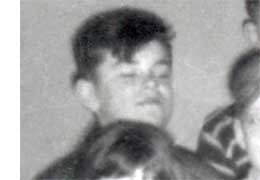 seven were in Miss Jordan's room (above) and grades eight to twelve were in the other room with the principal Mrs. McKillop.
seven were in Miss Jordan's room (above) and grades eight to twelve were in the other room with the principal Mrs. McKillop.
That's me, (right) I was seven at time time this was taken in the fall of 1951 and I was in grade three. I must say I was not a star pupil, though aware of things and eager to learn my first two years of school had been spent using a reading programme in which I only learned sight words and I was finding reading difficult as the teacher thought I should be able to sound out the words which to me were really just pictures.
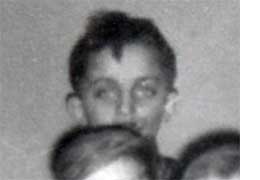 Langbank was a culturally diverse community, much different than the 100% Anglo-Saxon nature of Kelso and I found it both interesting and a challenge to come to terms with about one third of the class who were Hungarian. Between Langbank and Kipling, a large community to the west there was a rural Hungarian church called Békevár and people from that community were in Langbank, Kennedy (four miles away) and Kipling. On the left is Charlie Hoffer who was a farm boy and lived about six miles east of the village. Charlie and his family were to the best of my knowledge a Hungarian family.
Langbank was a culturally diverse community, much different than the 100% Anglo-Saxon nature of Kelso and I found it both interesting and a challenge to come to terms with about one third of the class who were Hungarian. Between Langbank and Kipling, a large community to the west there was a rural Hungarian church called Békevár and people from that community were in Langbank, Kennedy (four miles away) and Kipling. On the left is Charlie Hoffer who was a farm boy and lived about six miles east of the village. Charlie and his family were to the best of my knowledge a Hungarian family.
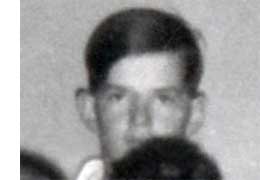 Even as the fifties began the days of the quarter section farm were numbered and there were a lot of these small operations clustered around the community. Low grain prices and the difficulties associated with the "wet years" which had just begun meant that it was hard for farmers on quarter section farms to make a living. Irvin Johnston (right) was the oldest son of the Johnson family who lived only a few miles from the village and they provided the community with fresh milk. Mr. Johnson delivered milk to our house each week and it was a luxury to us because in those days the milk was just as it came from the cow and that meant there was cream for hot chocolate.
Even as the fifties began the days of the quarter section farm were numbered and there were a lot of these small operations clustered around the community. Low grain prices and the difficulties associated with the "wet years" which had just begun meant that it was hard for farmers on quarter section farms to make a living. Irvin Johnston (right) was the oldest son of the Johnson family who lived only a few miles from the village and they provided the community with fresh milk. Mr. Johnson delivered milk to our house each week and it was a luxury to us because in those days the milk was just as it came from the cow and that meant there was cream for hot chocolate.
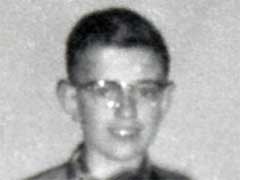 As I mention, Jack Hurst operated the power company for Langbank and he and his wife Mary had one son, Melvin. (left) Mary played for church and Sunday school, a chore she shared with Mrs. McKillop, the principal and she also taught music lessons. Jack not only ran the power plant but was an electrician, ran a Massey Harris implement dealership and a repair shop. Melvin was to become a remarkable musician working as a music and band teacher, music adjudicator and still is the choirmaster for a large Toronto Church. Melvin played at my wedding.
As I mention, Jack Hurst operated the power company for Langbank and he and his wife Mary had one son, Melvin. (left) Mary played for church and Sunday school, a chore she shared with Mrs. McKillop, the principal and she also taught music lessons. Jack not only ran the power plant but was an electrician, ran a Massey Harris implement dealership and a repair shop. Melvin was to become a remarkable musician working as a music and band teacher, music adjudicator and still is the choirmaster for a large Toronto Church. Melvin played at my wedding.
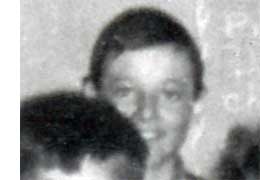 Emil Yuhaz (right) was the eldest in his family and I think his family lived on the family farm four miles east of the village. I did not know he, Stanley and Sandra very well and I think their farm was the "Willey" farm just east and south of the village
Emil Yuhaz (right) was the eldest in his family and I think his family lived on the family farm four miles east of the village. I did not know he, Stanley and Sandra very well and I think their farm was the "Willey" farm just east and south of the village
 Jim Cairns (left) has a sister Judy who must have been to young to be in school when this picture was taken. Jim's father Owen and mother Hilda lived on the Cairns farm north of Johnsons and had a very large cattle herd. For the time, it was a big farm and when Jim grew up he took over the place, formed a corporation with his brother-in-law George Stutt. They later sold the operation. Though no longer farmer I think he still lives in the area.
Jim Cairns (left) has a sister Judy who must have been to young to be in school when this picture was taken. Jim's father Owen and mother Hilda lived on the Cairns farm north of Johnsons and had a very large cattle herd. For the time, it was a big farm and when Jim grew up he took over the place, formed a corporation with his brother-in-law George Stutt. They later sold the operation. Though no longer farmer I think he still lives in the area.
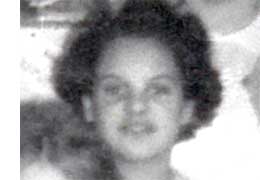 Phyllis Brown (right) was the oldest member of the Brown family. Her father, Stanley, operated a blacksmith and repair shop and some years later her mother, Tina, ran the village's only cafe. Stan Brown was a remarkable man, taught the senior Sunday School class in the United Church. Phyllis is one of those people who seems ageless. Though older than me she was always a person who could be counted on and was an excellent pianist and we sang in the choir all the time I lived in Langbank. Phyllis lives with her husband in Regina.
Phyllis Brown (right) was the oldest member of the Brown family. Her father, Stanley, operated a blacksmith and repair shop and some years later her mother, Tina, ran the village's only cafe. Stan Brown was a remarkable man, taught the senior Sunday School class in the United Church. Phyllis is one of those people who seems ageless. Though older than me she was always a person who could be counted on and was an excellent pianist and we sang in the choir all the time I lived in Langbank. Phyllis lives with her husband in Regina.
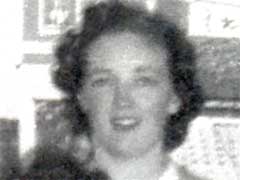 Our teacher (left) was Eileen Jordan who grew up in Kennedy just four miles away. This was my only year with her as my teacher as Gladus Hill took over the class the following year. Looking at her and that classroom with its radio/phonograph the difficulties of that era, teaching in a multi-grade classroom with little resources makes one appreciate the education that was delivered.
Our teacher (left) was Eileen Jordan who grew up in Kennedy just four miles away. This was my only year with her as my teacher as Gladus Hill took over the class the following year. Looking at her and that classroom with its radio/phonograph the difficulties of that era, teaching in a multi-grade classroom with little resources makes one appreciate the education that was delivered.
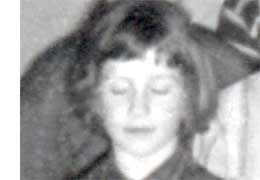 Janet Wallace (right) lived on their family farm across the road from the Johnson farm. Her father Frank was a hard working fellow but the little quarter section farm and marginal farm land made it hard to make a go of it. It puzzles me that her older brother Wayne is not in this picture. Wayne was a remarkable guy in that he was able to make sense of football and explained to us at lunch one day what a first down was and all the complexities of a game we only heard on radio. Six years later the farm was sold and the Wallace family moved away from the community.
Janet Wallace (right) lived on their family farm across the road from the Johnson farm. Her father Frank was a hard working fellow but the little quarter section farm and marginal farm land made it hard to make a go of it. It puzzles me that her older brother Wayne is not in this picture. Wayne was a remarkable guy in that he was able to make sense of football and explained to us at lunch one day what a first down was and all the complexities of a game we only heard on radio. Six years later the farm was sold and the Wallace family moved away from the community.
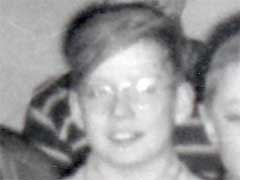 At the time this picture was taken Dennis Leanard (left) was my best friend. I was a new kid in town and though I got along with Billy Brown and Fred Wilton, I really liked Dennis and his cool older brother Roger. Dennis' father was the CNR station agent and as such, was an important person in a tiny Saskatchewan village in the early 1950s. Dennis seemed like a kid who was way ahead of his time, had great comic books and a super creative imagination.
At the time this picture was taken Dennis Leanard (left) was my best friend. I was a new kid in town and though I got along with Billy Brown and Fred Wilton, I really liked Dennis and his cool older brother Roger. Dennis' father was the CNR station agent and as such, was an important person in a tiny Saskatchewan village in the early 1950s. Dennis seemed like a kid who was way ahead of his time, had great comic books and a super creative imagination.
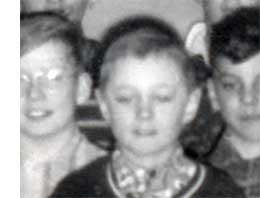 Stanley Yuhaz (right) was the second son of Frank Yukaz and as I said earlier I really did not know him that well.
Stanley Yuhaz (right) was the second son of Frank Yukaz and as I said earlier I really did not know him that well.
 Billy Brown (left) and I had so much to learn in life, be it learning to skate, curl, you name it, we were close in age and there were only about 12 children in the village so you had to get along. Billy and I were not close friends but rather more like working partners on just about everything including getting into trouble. But when it came to school work, especially math and science, Billy was the guy. I owe most of my high school science to Billy who patiently taught me physics (we did it by correspondence) and we grew up together. Billy was Phyllis' younger brother and the older brother of Eddy.
Billy Brown (left) and I had so much to learn in life, be it learning to skate, curl, you name it, we were close in age and there were only about 12 children in the village so you had to get along. Billy and I were not close friends but rather more like working partners on just about everything including getting into trouble. But when it came to school work, especially math and science, Billy was the guy. I owe most of my high school science to Billy who patiently taught me physics (we did it by correspondence) and we grew up together. Billy was Phyllis' younger brother and the older brother of Eddy.
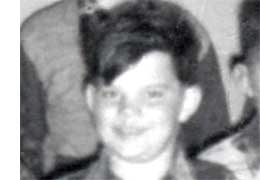 While Irvin played the role of older brother his brother Leslie Johnson (right) was the most pleasant good natured fellow in the class. He seemed to be in a good mood most of the time and always glad just to be at school each day.
While Irvin played the role of older brother his brother Leslie Johnson (right) was the most pleasant good natured fellow in the class. He seemed to be in a good mood most of the time and always glad just to be at school each day.
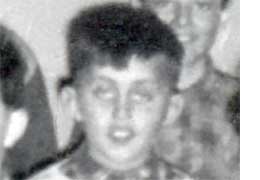 Alex Hoffer (left) was the younger brother of Charlie and I think they were related to the Yuhaz family.
Alex Hoffer (left) was the younger brother of Charlie and I think they were related to the Yuhaz family.
Every school, every class has a star, someone who is not just popular but talented and everyone's friend. 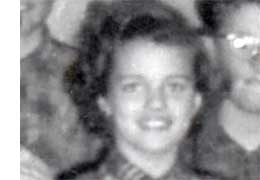 Wilma-Jean McKillop (right) was the class star. It wasn't easy being the only daughter of the school principal because school principals sometimes have to make pretty unpopular decisions but Wilma always was able to separate herself from her mother's role and be her own person. She was a gifted violinist and pianist not only filling in as the church organist but was an outstanding piano teacher. When I got involved in being a wedding singer it was Wilma-Jean who covered the keyboard for me. Wilma now lives in Vancouver.
Wilma-Jean McKillop (right) was the class star. It wasn't easy being the only daughter of the school principal because school principals sometimes have to make pretty unpopular decisions but Wilma always was able to separate herself from her mother's role and be her own person. She was a gifted violinist and pianist not only filling in as the church organist but was an outstanding piano teacher. When I got involved in being a wedding singer it was Wilma-Jean who covered the keyboard for me. Wilma now lives in Vancouver.
 Freddie Wilton (left) is one of the few people in this picture who is no longer living. He was at this time in 1951 a bit of a non-conformist and as the years went by seemed to become more so. His father was Tom Wilton and was almost opposite to Freddie's non-conformist attitude. Billy Brown and I learned a huge amount from Freddie Wilton, with him we went hunting, he worked a trap line with his uncle and showed us how to skin muskrats and beaver. I was not keen on that stuff because I just hated the blood on my hands but Billy was right into it and did some trapping of his own.
Freddie Wilton (left) is one of the few people in this picture who is no longer living. He was at this time in 1951 a bit of a non-conformist and as the years went by seemed to become more so. His father was Tom Wilton and was almost opposite to Freddie's non-conformist attitude. Billy Brown and I learned a huge amount from Freddie Wilton, with him we went hunting, he worked a trap line with his uncle and showed us how to skin muskrats and beaver. I was not keen on that stuff because I just hated the blood on my hands but Billy was right into it and did some trapping of his own.
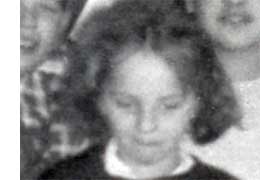 This is the younger sister of Charlie and Alex Hoffer but I do not remember her name.
This is the younger sister of Charlie and Alex Hoffer but I do not remember her name.
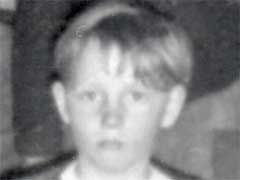 If Wilma Jean was the girl star of the class, one of the most popular boys around was Bobby Worley (left). It is funny how things stick with you.The picture at the top of the page is pretty aged and I needed to do more than an hour of restoration on the image and when I came to that sweater I could remember the pattern on it and the colour it was even though it must be decades since I last looked at this picture. It seems to me that it was only a short time later that he moved away.
If Wilma Jean was the girl star of the class, one of the most popular boys around was Bobby Worley (left). It is funny how things stick with you.The picture at the top of the page is pretty aged and I needed to do more than an hour of restoration on the image and when I came to that sweater I could remember the pattern on it and the colour it was even though it must be decades since I last looked at this picture. It seems to me that it was only a short time later that he moved away.
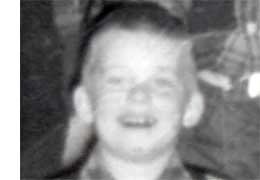 There are three people in the picture that I can not identify (right) and this is one of them.
There are three people in the picture that I can not identify (right) and this is one of them.
As I was doing the restoration of this picture and came to the image of Louise Foster (below) I really felt some strong emotions. Louise, as you can see was a thin pretty little girl and from the look of her in this picture you would never guess that she came from a really disadvantaged home. He father was Mike Foster who worked on the railway section gang but was known for his violent outbursts and the large family suffered considerably.
 Louise was the oldest and was the kid that everyone in the class picked on. It was cruel and uncalled for, kids should know better, but they don't and this little girl did not have a happy school experience. She was a bright kid, capable in class but shunned on the playground and teased mercilessly. I remember one time where it got the best of her and she lashed out with incredible anger at Wilma-Jean with nails cutting Wilma's hands. I stepped into the fight to stop either girl from getting hurt and was rewarded with nail marks on my hands that took a long time to heal. I will never forget the incident because Louise had reached the point where there was nothing else to do and as a grade four or five kid, I remember her with the tears streaming down her cheeks, after absorbing her attack, she just collapsed sobbing and clung to me for a moment. All that came back as I worked on the picture this afternoon.
Louise was the oldest and was the kid that everyone in the class picked on. It was cruel and uncalled for, kids should know better, but they don't and this little girl did not have a happy school experience. She was a bright kid, capable in class but shunned on the playground and teased mercilessly. I remember one time where it got the best of her and she lashed out with incredible anger at Wilma-Jean with nails cutting Wilma's hands. I stepped into the fight to stop either girl from getting hurt and was rewarded with nail marks on my hands that took a long time to heal. I will never forget the incident because Louise had reached the point where there was nothing else to do and as a grade four or five kid, I remember her with the tears streaming down her cheeks, after absorbing her attack, she just collapsed sobbing and clung to me for a moment. All that came back as I worked on the picture this afternoon.
 Sandra Yuhaz (right) is the younger sister of Emil and Stanley.
Sandra Yuhaz (right) is the younger sister of Emil and Stanley.
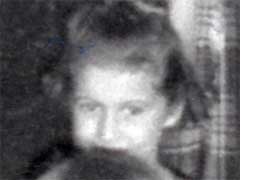 Louise Foster came from a fairly large family including Shirley, Patsy, Debra and David. I didn't recognise this individual (left) but Wilma-Jean thinks it is one of the sisters which is most likely Patsy.
Louise Foster came from a fairly large family including Shirley, Patsy, Debra and David. I didn't recognise this individual (left) but Wilma-Jean thinks it is one of the sisters which is most likely Patsy.
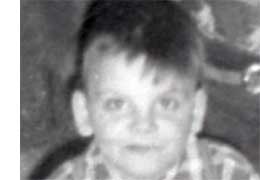 Eddy Brown (right) must have been in grade one in 1951 as he sits in the very front row of the class. He was the younger brother of Billy and Phyllis and some years later there was another girl, Shirley. Even in grade one Eddy was a smart-alec, the kind of kid that wanted attention and was far less likeable than his two older siblings.
Eddy Brown (right) must have been in grade one in 1951 as he sits in the very front row of the class. He was the younger brother of Billy and Phyllis and some years later there was another girl, Shirley. Even in grade one Eddy was a smart-alec, the kind of kid that wanted attention and was far less likeable than his two older siblings.
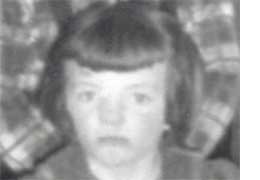 Dorothy Parker (left) was a neat kid. Her father, Jimmy, was the National Grain elevator agent and her mom, Betty, was a war bride and the village's hair dresser.Both of her parents were outgoing very popular people in the community and Dorothy was just like them and then some. Dorothy was almost bounded at the hip with her next door neighbour, Marilyn West, as the two of them grew up together sharing their lives and adventures until they finished high school.
Dorothy Parker (left) was a neat kid. Her father, Jimmy, was the National Grain elevator agent and her mom, Betty, was a war bride and the village's hair dresser.Both of her parents were outgoing very popular people in the community and Dorothy was just like them and then some. Dorothy was almost bounded at the hip with her next door neighbour, Marilyn West, as the two of them grew up together sharing their lives and adventures until they finished high school.
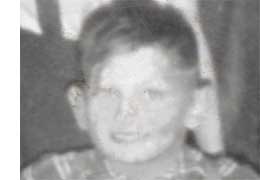 This kid (right) was the son of the minister at the Gospel Chapel. Though I don't remember his name that is an unforgettable face and he really was a miniature of his tall lean father. The Gospel Chapel was an evangelical church that preached salvation through being saved. Langbank was a religious community in 1951 with most people going to the United Church but people came from miles around to go to the Gospel Chapel. The Cairns family were the only Anglicans in the school and Dennis Leonard the only Catholic. The Hungarian folks were all Presbyterians and went to church at Békevár.
This kid (right) was the son of the minister at the Gospel Chapel. Though I don't remember his name that is an unforgettable face and he really was a miniature of his tall lean father. The Gospel Chapel was an evangelical church that preached salvation through being saved. Langbank was a religious community in 1951 with most people going to the United Church but people came from miles around to go to the Gospel Chapel. The Cairns family were the only Anglicans in the school and Dennis Leonard the only Catholic. The Hungarian folks were all Presbyterians and went to church at Békevár.
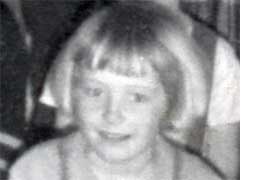 Marilyn West (left) was in grade one in this picture and as mentioned the first class buddy of Dorothy Parker. Besides being a charming little girl, Marilyn was the only kid in class with hair so blond it was almost white. Even at six she was outgoing and a chatterbox. She was the oldest daughter of Bill and Irene West. Bill was a mechanic, a trade he learned in the Army. Bill, Jack Hurst, Jim Parker, Own Cairns and Stanley Brown all had served in World War II as had the village post master Ted Burnett. Quite remarkable for such a small village. Marilyn and her husband live in Windthorst.
Marilyn West (left) was in grade one in this picture and as mentioned the first class buddy of Dorothy Parker. Besides being a charming little girl, Marilyn was the only kid in class with hair so blond it was almost white. Even at six she was outgoing and a chatterbox. She was the oldest daughter of Bill and Irene West. Bill was a mechanic, a trade he learned in the Army. Bill, Jack Hurst, Jim Parker, Own Cairns and Stanley Brown all had served in World War II as had the village post master Ted Burnett. Quite remarkable for such a small village. Marilyn and her husband live in Windthorst.
1951 is a long time ago, yet as I look at that picture it is not some other world but that life in Langbank was the foundation for all the things that would be the life I would lead. As I cleaned up the picture this afternoon I found that for the week that picture was taken I was the monitor for the library as my name is on the black board. Not in my wildest dreams would have ever thought that fifty-seven years later I would still be alive let alone cleaning up anomalies on a class picture with a computer.
The word computer was not used in 1951 although computers pretty much capable of some complex stuff had already been developed during World War II. In that little classroom working under Jack Hurst's electrical powered light which were bare bulbs hanging from the ceiling we were a long long way from the technological age of today but only six year after the end of the war.
If you see your self or a member of your family on this page, please get in touch with me, I would really like to hear from you. I am in contact with Wilma-Jean, Marilyn West and Melvin Hurst and have seen Phyllis and Billy a few years ago but I have not been in contact with the rest of the people on this page.
Return to Ensign |
| This page is a story posted on Ensign, a daily web site offering a variety of material from scenic images, political commentary, information and news. This publication is the work of Faster Than Light Communications . If you would like to comment on this story or you wish to contact the editor of these sites please send us email. |
Editor : Timothy W. Shire |